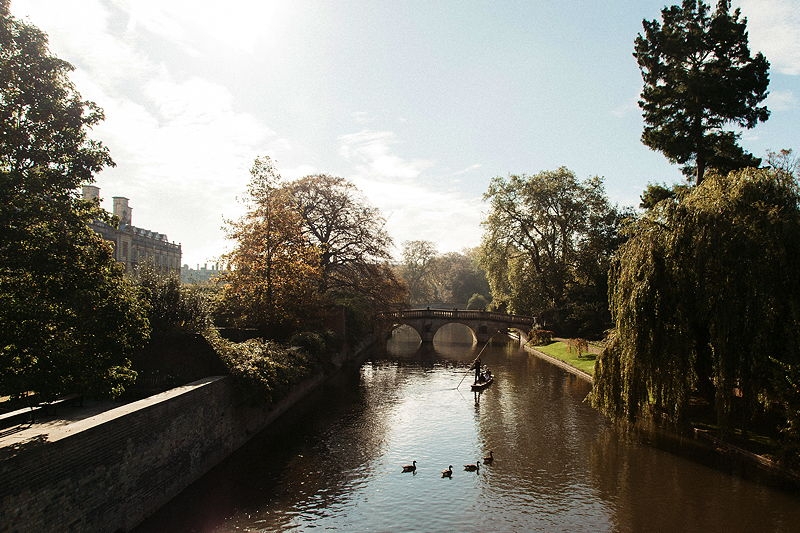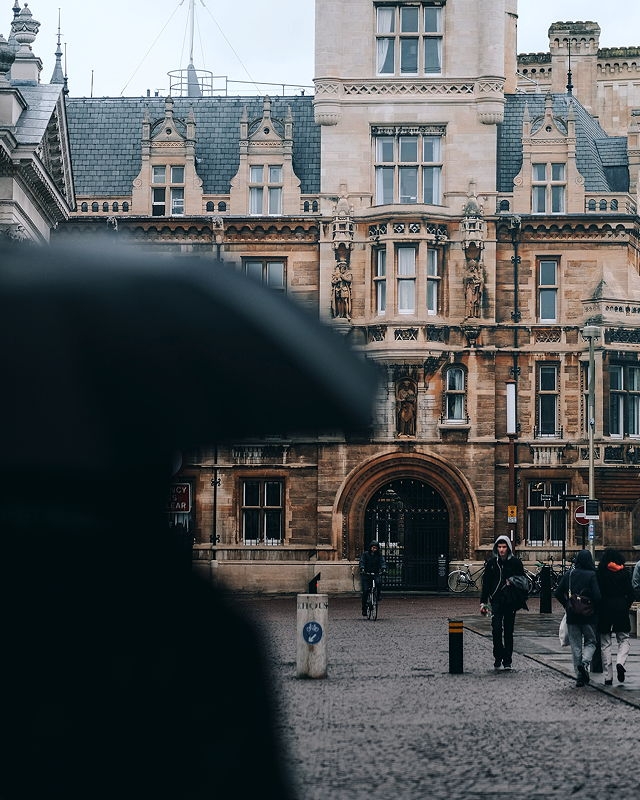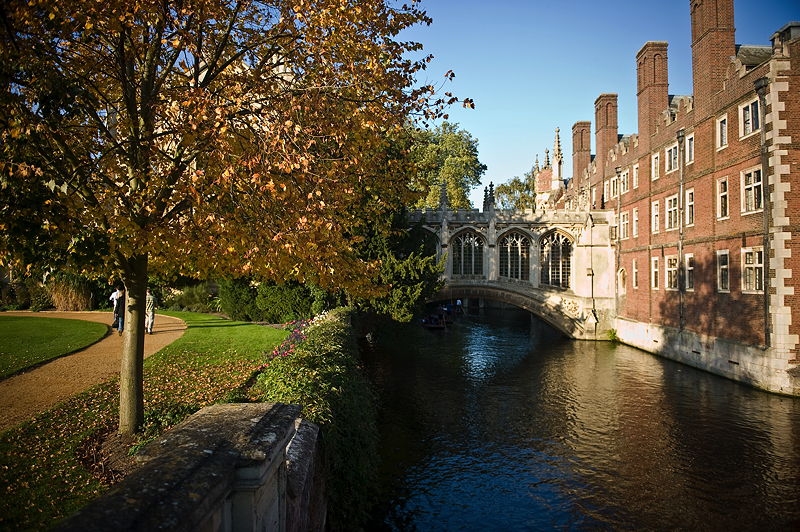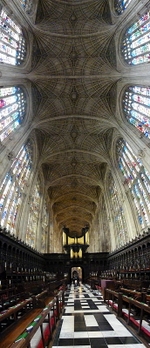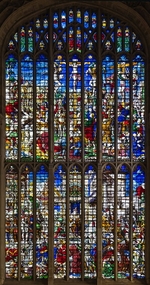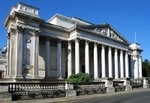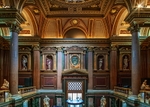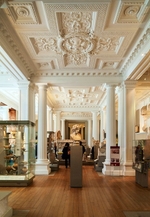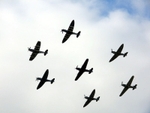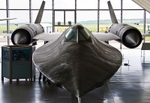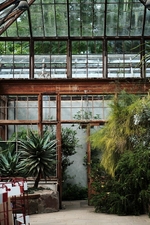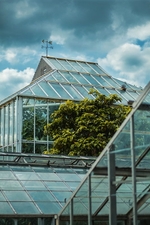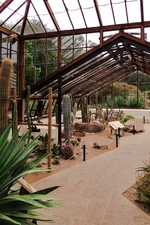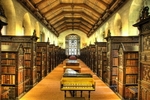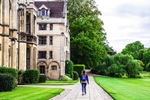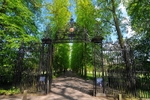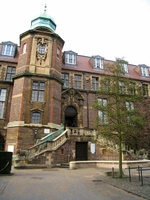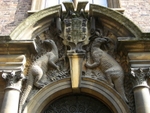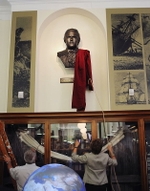1. King's College Chapel
The foundation stone of King's College Chapel was laid by King Henry VI in 1446.
Completed over a century later in the reign of King Henry VIII, the Chapel can now claim to be one of the most iconic churches and finest examples of late Gothic architecture in the world.
The Chapel is 239 feet long, 40 feet wide, and 94 feet high. Its most notable features include its intricately carved fan vaulted ceiling (the largest of its type in the world), medieval stained-glass windows (typically created by Flemish craftsmen between 1515 and 1531), and altarpiece (above which hangs Rubens' Adoration of the Magi).
The Chapel also houses an exhibition, which includes a chest in which Henry VII sent funds for the Chapel's construction.
The Chapel is also famous for its Choir, drawn from students of King's College and the nearby King's College School, who perform most days during term time and whose Christmas carol concert is broadcast on national television.
Those visiting the chapel can also explore King's grounds. Highlights include the Gibbs building (designed by James Gibbs and built between 1724 and 1732, where Word War I poet Rupert Brooke had rooms) and the Wilkins building (where novelist EM Forster lived for 30 years).
Where? King's College, King's Parade, Cambridge CB2 1ST. T: +44 (0)1223-331100.
When? With King's College a working college and chapel, opening times can vary slightly during the week, with the earliest admission from 9.30am. On Sunday, admission is from 10am. There are also occasions when the chapel will be closed to visitors. Check website for opening times and closures.
£$€¥ Adults: £10 online advance rate; Seniors, Concessions, Children 6-17: £8; Children 5 and under: free.
2. The Fitzwilliam Museum
The Fitzwilliam Museum is the art and antiquities museum of the University of Cambridge.
Receiving over 300,000 visitors a year, this medium-sized museum holds a remarkably varied, high-quality and beautifully curated collection. It is housed in the imposing, classically-designed Founders Building.
The Museum's works are arranged into departments, including:
- Antiquities: artefacts ranging from stone coffins to seal-stones and gold and silver jewellery.
- Applied Arts: holding about 20,000 pieces of decorative art and sculpture from Europe, India and the Middle and Far East;
- Coins and Medals : displaying almost 200,000 items, including a Victoria Cross and the Ides of March denarius, struck in 42/43BC and with a likeness of Brutus stamped on the coin—the Roman Republic's most famous coin;
- Manuscripts and Printed Books: displaying works by Thomas Hardy and Virginia Woolf, and autograph scores by Handel and Elgar; and
- Paintings, Drawings and Prints: including masterpieces by Titian, Rubens, Constable, Turner and Gainsborough. The museum's impressionism collection is particularly impressive. It includes four works by Monet: two seascapes, a delightful picture of an orchard at Monet's beloved Giverny called Springtime, and one of his Poplar series. Cezanne is also well-represented, with The Abduction (from his Dark Period), Still Life with Applies, and Landscape: A Forest Clearing. Other impressionists on show are Renoir and van Gogh.
The Museum's highlights include Rubens' The Death of Hippolytus, Monet's Poplars and Stanley Spencer's Self-portrait with Patricia Preece.
Where? Trumpington Street, Cambridge. T. 01223 332900. E. fitzmuseum-enquiries@lists.cam.ac.uk.
When? Tues to Sat: 10am to 5pm; Sun/Bank holiday Mondays: 12 noon to 5pm; Closed: Other Mondays, Good Friday, Dec 24-26, Dec 31, Jan 1.
£$€¥ Free.
3. The Imperial War Museum Duxford
Duxford achieved fame as one of the first RAF bases to deploy the Spitfire.
It now houses a branch of the Imperial War Museum, together with the American Air Museum. Over 200 planes are on display, together with many tanks, artillery and small naval vessels.
The main exhibition space—the 12,000 square metre AirSpace Hanger—holds over 30 aircraft, including a Spitfire, a Lancaster, a Vulcan, a Harrier and a Concorde. Hanger 3 is devoted to the Museum's Air and Sea exhibit, which displays a number of vessels and naval aircraft including a Vosper motor torpedo boat and a Wasp helicopter.
The Battle of Britain Exhibition is the highlight of Hangar 4, complete with a Messerschmitt Bf-109E forced down over Sussex in 1940.
The American Air Museum—built in memory of the 30,000 US airmen who lost their lives flying from British bases during the second world war—is housed in a Norman Foster designed hangar; inside visitors will find a vintage B17 Flying Fortress, a SR-71 Blackbird (the plane which holds the flight altitude record of 85,069 feet), and a 200-feet wide and 52 feet tall B-52 Stratofortress bomber.
The Museum's grounds contain an active airfield, with two parallel runways, which hosts a number of international air shows each year.
Where? Imperial War Museum Duxford, Cambridgeshire, CB22 4QR. T. +44 (0)1223 835 000.
When? 10am to 6pm daily except 24-26 December. Last entry at 5pm.
£$€¥ Adults (16-64 years): £25. Seniors (65+) and Students: £22.50. Children (5-15): £12.50. Children under 5: Free. Book online for advance tickets.
4. The Cambridge University Botanic Gardens
Established in 1846 by Professor John Stevens Henslow, teacher and mentor to Charles Darwin, the Botanic Gardens is a 40-acre oasis of tranquillity close to Cambridge's town centre.
The Gardens contain over 8,000 species housed in gardens and glasshouses, including national collections of tulips and geraniums.
Glasshouse Range
The 80 metre Glasshouse Range is the main draw. The structure has been gradually expanded over the decades, which gives it a homely and ramshackle feel. It is most famous for the central Palm House, which together with its outer wings are dedicated to representing tropical rainforests, as well as the Mountain House with its raised beds that mimic alpine conditions displaying seasonal flowers such as irises, tulips and snowdrop.
Visitors should also look out for the carnivorous plant, oceanic island and arid lands collections.
Outside gardens
Outside, don't miss the central U-shaped lake, covering an area of almost an acre, flanked by willows and other beautiful trees, and adjacent to the Winter and Rock Gardens.
The Chronological Garden is another must-see. This garden charts plants introduced to Britain as far back as Roman times through to the 16th century, from whereon the borders are divided in to 20 year intervals up to modern day. This offers a fascinating insight to when some of our favourite plants were introduced to the nation.
Other features of note include the Scented and Rose Gardens and the tranquil fountain adjacent to the Glasshouse Range.
Enquire about the free weekend drop-in tours, where you can enjoy the garden in the hands of an expert guide.
The Gardens also feature a well-run Cafe offering drinks, snacks and light lunches inside or on its lovely outdoor terrace, and an extensive gift shop.
Where? University Botanic Garden 1 Brookside Cambridge CB2 1JE 01223 336265.
When? Apr - Sept: 10am - 6pm; Feb, Mar & Oct: 10am - 5pm; Nov, Dec & Jan: 10am - 4pm. Closed 24 Dec 2022 to 1 Jan 2023.
£$€¥ Adults: £6.80; Children 0-16 inclusive: Free.
5. The Colleges
The University of Cambridge, formed in the 11th century, is the second oldest university in the English-speaking world.
It is one of the world's foremost educational establishments, having taught over 60 Nobel laureates (the most of any university in the world), 15 British Prime Ministers, and at least 25 foreign heads of state.
Its former students and staff include Sir Francis Bacon, Sir Isaac Newton, Lord Kelvin (thermodynamics), Lord Rutherford (nuclear physics), Charles Darwin, Francis Crick and James Watson (DNA) and Stephen Hawking.
All students and academic staff belong to one of Cambridge's 31 colleges. Those colleges fulfill educational and pastoral roles, providing 'supervisions' and accommodation for undergraduates.
A typical college comprises a hall for dining; a library; a bar; senior, middle and junior common rooms (for dons, postgraduates and undergraduates respectively); a chapel; and accommodation for around 300 undergrads, the head of the college and its dons. Given the age of the university, many colleges contain impressive architecture and grounds.
We particularly recommend: Trinity College, founded by Henry VIII in 1530, with its large Great Court, impressive Clock Tower (pictured) and classical Wren library; St John's College, and its charming Bridge of Sighs crossing the River Cam; and Queen's College, and its Old Court dating back to 1448 and striking 'mathematical' bridge.
Where? The colleges are located within easy walking distance of central Cambridge.
When? Most colleges welcome visitors all year round. Check their websites before visiting.
£$€¥ Some colleges charge tourists a small fee. Check their websites before visiting.
6. The Backs
The Backs is the name given to the area of outstanding natural beauty located behind seven of Cambridge’s colleges, and backing onto the River Cam.
Landscaped gardens, famous for their crocuses and daffodils in spring, are found to the east of Magdalene, St John’s, Trinity, Trinity Hall, Clare, King’s and Queen’s colleges. The gardens back on to the River Cam, a tributary of the Great Ouse River which flows to the North Sea at King’s Lynn, some 40 miles from Cambridge.
A number of picturesque bridges cross the Cam, including the famous Bridge of Sighs (a covered bridge, loved by Queen Victoria, linking two of the quadrangles of St John’s College) and the wooden Mathematical Bridge.
Punting is a popular activity in summer between Jesus Lock and Grantchester; several companies hire punts, with or without punt chauffeurs. We recommend being taken on a guided tour (punting is hard work and the river can get busy at peak times).
The Scudamores tours are very good: the tour guides are typically knowledgeable and well-spoken Cambridge university students earning a bit of spending money!
Where? The area in central Cambridge between Magdalene Street bridge and Silver Street bridge.
When? Year round. Check website for details.
£$€¥ Hiring a punt for an hour will cost between £20 and £30. Scudamores shared punt tours cost from £50 .
7. The Sedgwick Museum
Opened in 1912, and housing 1.2 million specimens, the Sedgwick Museum of Earth Sciences is the geology museum of the University of Cambridge.
The Museum's 10 exhibitions allow visitors to walk through over 500 million years of the history of life on earth.
The Ancient Life exhibition charts the first signs of life on earth, the development of marine life and the first mammals; highlights are fossils from the Ediacara mountain range dating from 500 million years BC, and a cast of the fossil of the world's largest spider, the 50-centimetre diameter Megarachne.
The Dinosaurs exhibition includes a complete Iguanodon skeleton (a 10-metre long lowland herbivore), the skull of a Megalosauras (meaning great lizard, a 9-metre long carnivore) and the fossilised remains of Polacanthus and Raptors. Finally, the Darwin the Geologist exhibition chronicles Darwin's Voyage of the Beagle (1831-1836).
The artefacts on display include Darwin's journals, pistol and a reconstruction of Darwin's cabin on board The Beagle showing the rock specimens he collected from an island south of Chile. Darwin's subsequent account of the five year voyage, published under the title Journal and Observations, brought him fame and repute.
Where? The Sedgwick Museum of Earth Sciences, University of Cambridge, Downing Street, Cambridge CB2 3EQ.
When? Mon-Fri: 10am to 5pm. Sat: 10am to 4pm. Closed Sun.
£$€¥ Free. No booking required.
